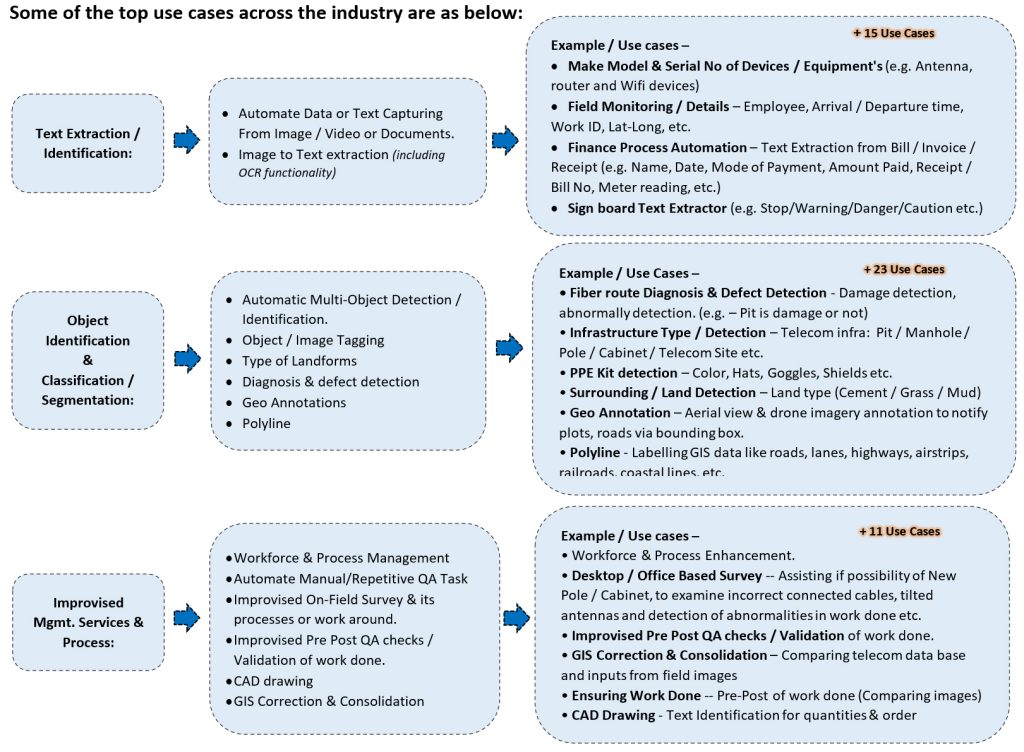
In my previous blogs, I shared insights about computer vision, how it works, what are the current challenges faced by the business, some interesting use cases across the industries, and how RMSI’s Computer Vision Solution can help clients to overcome their concerns and challenges.
In this blog, I would be focusing on the Telecommunications industry which is no longer limited to just telephones and internet services. It is now the center of technological advancements with an immense focus on Artificial Intelligence. AI has taken over this industry and has successfully replaced the traditional and complicated ways with new algorithms, making it easier to analyze and process vast volumes of data collected from multiple consumer bases, especially through computer vision techniques. We will learn how Telecom businesses are reshaping their operations with the help of computer vision use cases and applications. Also sharing some interesting stories, where RMSI has helped businesses to take off and reach remarkable heights.
Key Telecom challenges
Telcos around the world are currently engaged in substantial investments in network implementation, deployment & upgrades to keep up with today’s growing demands of high-speed, reliable connectivity, etc. From Fiber Backhaul, Gigabit Fiber Broadband, to 5G Wireless Deployment, there is huge volume of work.
Some of the key challenges for telcos are:
- Highly Human dependent processes (Less accurate)
- Countless Mundane – Manual & Repetitive efforts
- Low Delivery Speed & High growing demands
- High Operational expenditure
- Need robust Managing & Maintaining team & skilled resource
- Lac’s of photos reviewed manually per year & Need full time skilled staff for Inspection & QA checks
- Exponential increase in customer demands.
- Meet up financial target even after high expenditure.
This is where AI/ML comes into play – Automation of Repetitive Tasks/Work & Complex Processes along with the reduction in Human interventions helps to speed up delivery, improves accuracy which is achieved by eliminating Human Error, and provides notable cost savings.
Telecom Use Cases – with Key Benefits Our real-time, high-quality AI/ML-based approach with algorithms identifies the content automatically and solves a wide range of industry use cases across multiple domains/verticals.

With such a density of use cases, telecom industry is benefiting from the advancements in computer vision and with technology getting mature we expect more & more use cases to come in the future and industries are bound to grow – drastically along with cost-saving & efforts.
Below are some examples that showcase the benefits of Computer Vision.
As telecom industry involves a lot of fieldwork including a large no of Invoices, bills, and timesheets & field details (including telecom infrastructure & device details) – which are taken via Survey which can be in the form of Images / Videos / Documents. If you see the below examples you would understand how computer vision can be quick, accurate – effective, cost-saving, and reduces repetitive & mundane work.
As referred below just compare the time taken by Humans to Visualize, Analyze and interpret such inputs v/s the time taken by machines (i.e. Computer Vision)

Key Benefits
- 95% – 1st time right identification / resolution rate.
- 95% – Accuracy in identification & validation.
- 85% – Reduction in manual work.
- 20% – Increase in revenue through optimizing costs.
- 92% of Efforts saved, which were utilized for analysis/validation in Pre.
Key Takeaways:
In this blog, we saw how Computer Vision technology provides remarkable improvements to telecommunication industries and enables next-generation technologies (AR/VR, Smart City, Sensors/IoT based monitoring, Smart Car – Driverless Cars, etc.) across domains along with remarkable benefits & cost savings.
In my next blog in the series, I will share more on how Computer Vision plays a vital role in enabling & helping to increase the footprint of AR & VR / metaverse use cases/applications, and how RMSI’s Computer Vision solutions will help to achieve to it.
For more computer vision topics or other tech industry-related materials, check out the RMSI Blog